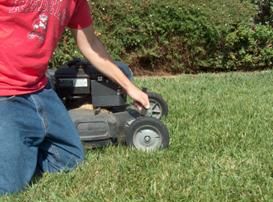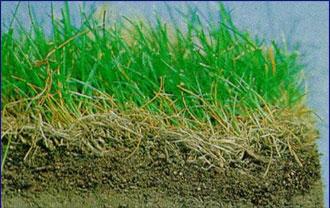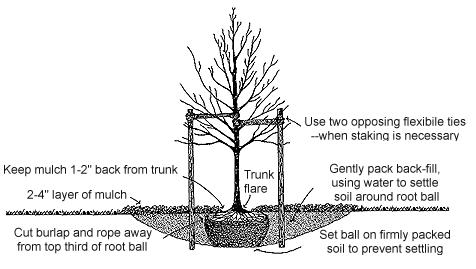Turf is by far the largest water user in a garden as well as the area that needs the most attention to maintenance during the growing season. Water conserving lawn maintenance involves a number of cultural practices.
Proper mowing, irrigation, aeration, de-thatching, weed, insect and disease control, and fertility can prevent a lot of the problems experienced in home lawn care. With the right care, you can have a dense, healthy, high quality turf that requires less water.
As a first step, it is important to know what kind of turf grass you have as different types have different growing seasons and different maintenance needs.
All too often, a lawn will begin to turn brown simply because it is at the end of its growing season while the homeowner starts watering more frequently thinking that it must be too dry.
Mowing
The importance of good mowing practices is often overlooked but has a major influence on turf density, uniformity, aesthetic quality and even the water needs of a home lawn. It is the most repetitious and time-consuming maintenance practice, but is also the most abused. The goal is to have a healthy, neatly trimmed lawn that is deep-rooted.
Frequency and Cutting Height
The frequency and height of cut are two important considerations and will vary depending on species of grass and growing conditions. Turf grasses can be mowed frequently, provided that no more than one-third of the grass blade is removed in a single mowing.
Cutting shorter than this means the grass plant has to use carbohydrates from the root reserves to initiate new growth. Repeated scalping of the turf weakens the root system, directly affecting the ability of the turf to obtain water and nutrients.
Lower mowing produces a shallow root system, making the grasses more succulent and susceptible to heat and drought stress and disease injury.

Set the mower at the next highest level from the one typically used; this is usually an easy hand adjustment on the wheels. A higher height of cut gives a better safety margin, because the grass is hardier, more drought resistant, less disease susceptible, requires less water and remains green longer than when cut shorter. Use the following guidelines:
- Bluegrass – 2 to 2 ½ inches
- Tall fescue – 2 to 3 inches
- Warm season grasses ( Bermuda, zoysia, etc.) – 1 inch
Equipment
Mowing equipment should have the capacity and power to handle the area to be mowed. Other considerations in equipment selection should be weight, maneuverability, ease in starting, ease of adjustment of height of cut and safety features providing protection from mower blades.
Reel type mowers provide a better cutting action than rotary mowers, but are seldom used on home lawns because of their high initial cost and maintenance requirements, and also because they are more difficult to use than rotary mowers.
A rotary mower will provide adequate mowing if the cutting blade is kept sharp; otherwise, it tears or shreds grass blades, producing a dull, gray-brown overcast appearance that can be misinterpreted as symptoms of other turf problems. Grasses with shredded leaf tips are also more easily infected by disease organisms. Debris such as sticks, stones, wire, etc. should be removed before mowing to prevent possible injury.
Grasscycling
Grasscycling is the natural practice of leaving clippings on the lawn when mowing. This can save time, money and other resources like landfill space. The clippings quickly decompose, returning nutrients to the soil.
Grass clippings should not be removed from a home lawn unless they are excessively heavy. Clippings have a high nutrient value, breakdown rapidly and do not contribute significantly to thatch. Leaving the clippings on the lawn can reduce the need to fertilize with additional nitrogen.

Aeration and De-Thatching
Thatch is a layer of partially decomposed organic matter that builds up in between the lawn and soil surface. It is a common problem on home lawns, particularly for lawns that have been established for several years.
An excessive thatch layer can restrict grass root penetration into the soil root zone, resulting in a lawn with shallow root systems. Thatch can also interfere with water infiltration as it repels water, increasing runoff during irrigation and requiring longer irrigation times in order for the turf to receive enough water.
Thatch provides a perfect winter survival and growing environment for insects and diseases. If thatch is kept to a minimum, then insect and disease-related problems are also reduced. When a thatch layer is present, the lawn feels very spongy when walking across it.
By cutting a triangular patch of turf with a sharp knife and lifting it back, the thickness of the thatch layer can be measured. If thatch is more than 1/2 inch thick, you should consider de-thatching your lawn.
If excess thatch is present, mechanical removal by vertical mowing using a de-thatcher should be done gradually. Another method of controlling thatch is aerating. The hollow steel tine core aerator removes cores of soil which physically breaks up the thatch as well as bringing up beneficial soil microorganisms that help break down the thatch.
De-thatching or aeration should be done in either the spring or fall during periods of good growth, allowing for quick lawn recovery. Aeration can be done yearly; de-thatching should only be done every few years as it is destructive to the existing grass and has a longer recovery time.
Lawn Replacement
If you find that you are not using your lawn area for any purpose other than to mow, you may want to consider reducing the size of your lawn or replacing it with groundcover or even native grasses.
Since turf has one of the highest water needs and requires regular maintenance, it is worthwhile considering options if you do not need an expanse of green lawn for recreation or pets.
Lawn areas can be reduced by expanding shrub beds, adding a garden path or creating a small patio area. If you add a path or patio, try to use surfaces that will allow some water infiltration as this will help the surrounding planting areas.
If your lawn is ready for an update, there are a number of options that will give your garden a new look.
Native Grasses
Native grasses can be a great alternative to traditional lawns and will use much less water. Native prairie grasses may be good options as ornamentals or non-functioning lawn areas. Some common grasses that are native to North America include blue gramma, switchgrass, and buffalo grass. Here are some tips for locating native grass seeds in your area.
When calling suppliers about native grass, it helps to do a little research and be as specific as possible about what you would like. Most native grasses are supplied in seed form.
In general experts recommend using grass seed from stock which originated from no more than 300 miles of your location, preferably from within 100 miles. This is not always possible. Often the supplier will tell you the general area in which it was harvested.
Check with a number of suppliers as prices vary as will the variety of seeds. Occasionally a supplier will have a rare harvest of a different prairie grass which may interest you.
The important thing to find out before you make the change is to know what it looks like (both growing and dormant), what the water needs are, its growth characteristics (how it spreads and height), and its maintenance needs.
Maintaining Trees And Shrubs
Trees and shrubs are usually the most valuable plants in a garden. Caring for them properly from initial planting through maturity will produce stronger, healthier plants and reduce water needs over the long term.
Planting
Planting new trees and shrubs properly will help reduce water needs over time. Plants that start out struggling with a poor planting environment may never gain the strength and vigor that they need to be less water dependent later on.

Pruning
Pruning is used to guide plant shape and correct poor structure, but it also encourages new growth (which may increase plant water needs).
Understanding the natural growth habits of your trees and shrubs, and pruning with those forms in mind, will minimize pruning needs.
Prune for Plant Needs
- Prune to natural form and shape; avoid shearing unless it is a hedge.
- Prune all sucker growth and water sprouts (growth shooting straight up from the base or off the main trunk or branches of trees)
- Prune after flowering, at the end of the growing season, or during dormancy, depending on plant needs.
Different plants have different pruning requirements. It is important to know when to prune so you have the best flowering and healthiest growth, and don’t unknowingly remove necessary branches for next year’s growth.
If your region is experiencing a drought or water use is restricted, limit pruning to the removal of dead, damaged or diseased branches, dead foliage and flowers. Pruning encourages new growth, which is much less tolerant of reduced water uptake.
Fertilizing
Fertilizing provides nutrients to maintain plant health and also encourages new growth. Understanding and implementing a well balanced fertilizer program is one of the most important factors in maintaining a healthy lawn and garden.
Factors that will determine the most suitable fertilizer regime are soil type, climate, irrigation, plant types, and for lawns, mowing practices and species of grass. Excessive use of fertilizers can cause rapid growth that is more susceptible to pests and disease.
The three main nutrients are nitrogen, phosphorus and potassium. Most fertilizers available at garden centers contain a combination of the three.
- Nitrogen: Nitrogen promotes dark green color, leaf and blade development and density of the turf.
- Phosphorus: Phosphorus is important for good root and rhizome development and promoting plant maturity.
- Potassium: Potassium contributes to the general vigor of the plant and promotes wear and drought tolerance and hardiness against winter injury.
Fertilizing Trees and Shrubs
Apply fertilizers directly to the planting area, in root zones where the plants can use the nutrients. Avoid over-spreading or spraying onto hard surfaces where the fertilizer can wash off the property and into the storm drain system or local streams and creeks.
Fertilizing the Lawn
The amount of nutrients required by a home lawn is most accurately determined by soil testing. A soil test will determine levels of phosphorus, potassium, pH and mineral requirements. Nitrogen has to be replenished every year, while phosphorus and potassium are relatively stable in the soil.
On newly established lawns, higher levels of phosphorus and potash may be required. If the lawn is on sandy soil, higher potash or more frequent applications may be required as it may be subject to leaching under these conditions.
Various forms of nitrogen are used in lawn fertilizers for homeowners. Water soluble or inorganic nitrogen fertilizers such as ammonium nitrate and ammonium sulfate supply a form of nitrogen that is immediately available to the plant. The response of turf is a quick greening.
However, this form of nitrogen is readily leachable and can cause lush growth if applied in hot or dry conditions. It also has high potential to burn the turf.
Natural organic fertilizers such as activated sewage sludge rely on soil microorganisms to break down the organic compounds into a nitrogen form that can be taken up by the grass roots. These forms of fertilizers depend on soil temperature to release nitrogen and the rate of release may vary with the product.
Although urea is sometimes referred to as an organic form of nitrogen, it reacts similarly to water soluble carriers in the soil and is therefore referred to as a water soluble nitrogen form.
Synthetic organic forms of nitrogen such as IBDU, ureaformaldehyde and sulfur coated ureas provide slow release properties that reduce nitrogen leaching and have lower potential for burning turf due to a low salt index. These forms are generally more expensive than the water soluble or organic forms of nitrogen. However, their slow release characteristics coincide with soil temperature and moisture conducive to good turf growth.
Fall fertilization with slow release nitrogen fertilizers has proven to be beneficial to home lawns. Late fall fertilization when the vertical shoot growth has ceased increases fall and spring root growth and encourages active tillering, therefore promoting a thicker stand.
The lawn comes out of the winter in a green condition and does not give the rapid flush of shoot growth that occurs with spring-applied nitrogen.
Garden Care Resources
US Environmental Protection Agency – Water Use Efficiency Program
University of California Agricultural and Natural Resources
International Society of Arboriculture Consumer Information Program
Family of Southern California Water Agencies
Southern Nevada Water Authority
- Hiring a Landscape Professional - January 19, 2017
- Water-Wise Plant Materials - January 13, 2017
- Water-Wise Plants Timing and Seasonality - January 13, 2017
